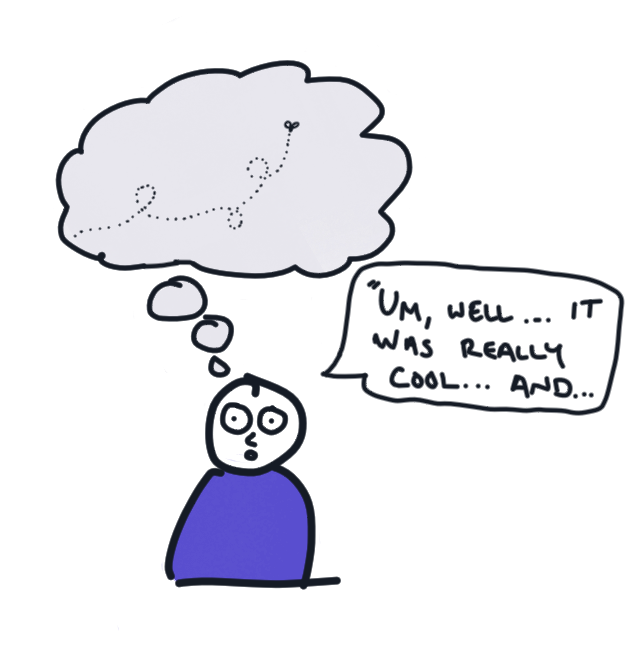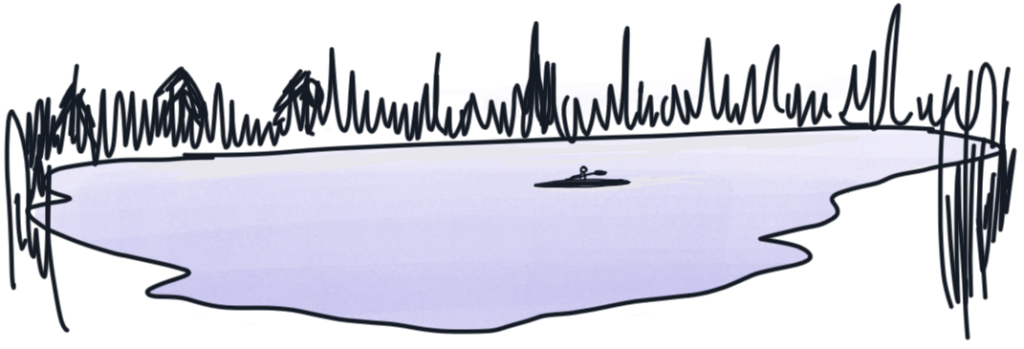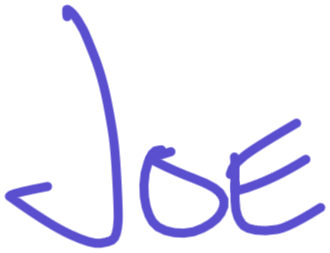Condition 002
Verbalized ideas flow away like rivers;
visualized ideas persist like lakes.
What’s captured visually can be accessed, shared, and built upon indefinitely.
During countless meetings, I have experienced a maddening phenomenon. I would follow someone’s thinking in real-time, nodding along with clear understanding. Yet later, this clarity would somehow evaporate when I tried to explain it to someone else.

Person struggling to articulate thoughts, depicted with a speech bubble indicating hesitation and an empty thought bubble with nothing but a buzzing fly flying an unclear path.
I wasn’t mindlessly agreeing—I was truly tracking with their ideas. But afterward, I couldn’t reconstruct the meaning that felt so tangible in the moment. This pattern wasn’t unique to meetings. The same thing happened with listening to podcasts or hearing people talk at conferences—there was a sense of meaning I could feel, but that dissolved as soon as I attempted to share it with others.
What changed this for me was taking hand-written notes as I listened–no, duh, right?
Hear me out.
By not relying on recordings or word-for-word notes, and instead using simple diagrams to show connected ideas the notes I was taking didn’t just improve my recall; they became shared reference points. I could check my understanding of what we were talking about with others, giving them a shared way to think about the conversation as well.
When conversations become artifacts, understanding outlasts memory.
What conversations have disappeared from your memory recently?
What meeting this week could benefit from visual capture?
Verbal information flows like rivers—rushing past one piece at a time. Visual information exists like lakes—all elements visible all at once.

Creating visuals during meetings transforms fleeting words into references that are useful long after the meeting ends. This practice not only enhances understanding in the moment but creates shared anchors that extend collaboration across time—even for people who weren’t present for the original discussion.
Thanks for reading,


Confident Moves
Try this in less than 10 minutes (full confession, it took me 12 minutes, because the TED talk I watched was 12 minutes):
Watch a TED talk & take notes with a pen.
- Prepare your tools before starting the video.
Have a blank piece of paper and pen ready. Give yourself permission to make something that looks kinda shitty—the goal is to capturing meaning, not to be artistic.
Don’t believe me? Look at my notes for this exercise. - Watch the video and take notes in real time
Just absorb the content, noticing what stands out to you. Remember, you’re creating a lake, not trying to capture the entire river. - After the talk ends, spend a moment with your visual artifact
Notice how your notes allow you to “replay” the talk. Did your notes follow a linear order or did they create some other shape? - [Optional] Do it again…
How would you approach taking notes on the same talk if you did it a second time? What would you do the same and what would you do differently?

Want to go deeper?
Read the full article on this topic:
Beyond the Moment: How Visual Artifacts Preserve Understanding